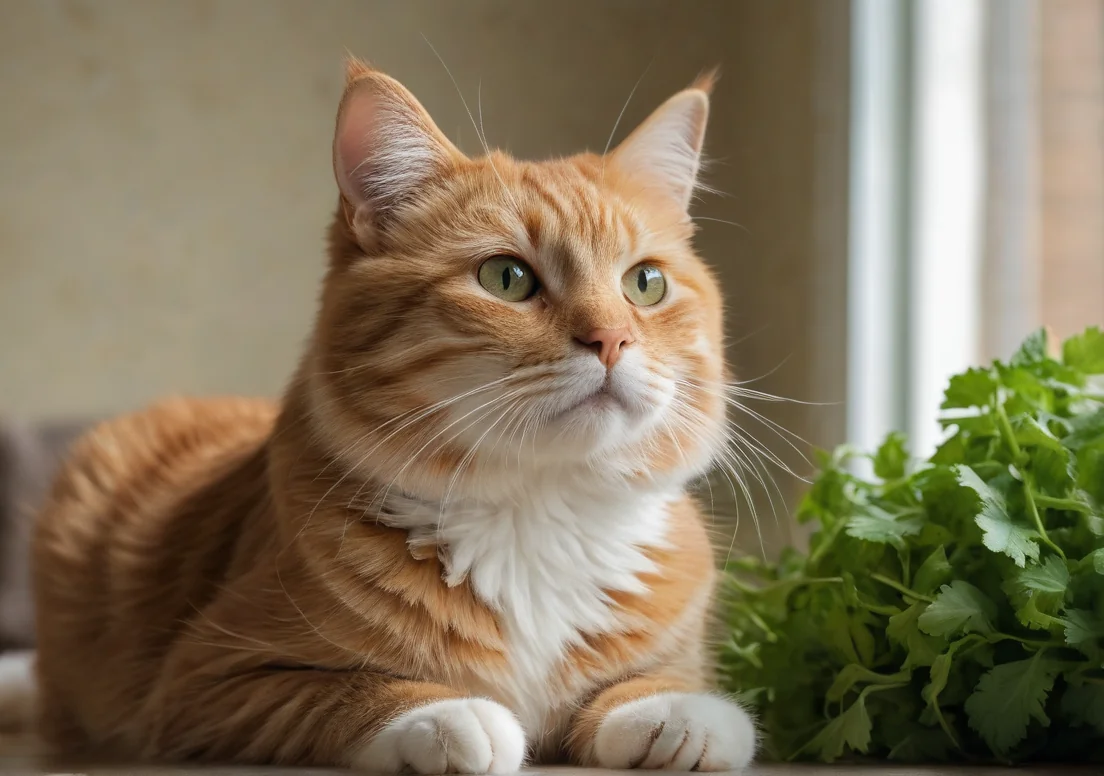Cats are known for their unique tastes, but cilantro? That’s a curious one! Many cat owners have noticed their feline friends showing an unusual fondness for this herb, sparking questions and intrigue.
So, why do cats like cilantro? The answer lies in their olfactory receptors, as cilantro can mimic the scent of certain cat pheromones which are appealing to them. This connection makes cilantro an intriguing herb for many cats, leading to their unusual attraction. But there’s more than just this simple answer—there’s an engaging story behind their cilantro obsession waiting for you!

What is cilantro and why do cats notice it
Cilantro, also known as coriander, is a flavorful herb widely used in culinary dishes around the globe. With its fresh, citrusy aroma and bright green leaves, it stands out among herbs. So why does it catch a cat’s fancy?
Cats are naturally curious creatures, and cilantro’s distinct scent can be quite stimulating for them. Unlike other common herbs, cilantro contains compounds that may pique a cat’s interest, mimicking some of the scents linked to their natural prey. Additionally, it’s believed that the volatile oils in cilantro might trigger a reaction similar to that of catnip. For some felines, this creates a peculiar form of attraction, making them want to sniff, nibble, or even roll around in it.
It’s not just the smell, though. This herb’s bright color and foliage might also play a role in catching a cat’s eye. Any vibrant greenery in their environment frequently prompts exploration, leading to playful interactions with cilantro.
How does cilantro affect a cat’s senses
The true magic of cilantro isn’t just its culinary zest; it’s how it engages your cat’s senses, particularly their sense of smell. Cats have an incredibly refined olfactory system—about 14 times more acute than humans—allowing them to pick up scents that we often overlook. When your cat encounters cilantro, they might find the herb’s aroma intriguing and worth investigating.
The allure of cilantro might be heightened due to her individual taste and past experiences. Each cat has its preferences, which can be influenced by their diet or even their environment. For some, the scent of cilantro could be reminiscent of other herbs or plants they enjoyed or explored previously, triggering a joyful curiosity.
In addition to smell, experiencing cilantro might provoke a tactile response, as cats often react playfully to things they can touch and bat around. It might feel exciting for them to romp over the leaves or even chew on the herb, adding a fun twist to their day.
For more information about how herbs can affect your pet’s senses, check out this resource from the ASPCA: ASPCA Pet Care.
While cilantro is not harmful to cats in small amounts, it’s always good practice to monitor them. Each cat is different, and their reactions can vary widely, so keep an eye out for any signs of digestive upset if they decide to snack on those vibrant leaves. Consider integrating it into their playtime for a unique experience while ensuring their safety.
Are there any nutritional benefits for cats?
Cilantro may not be a staple in a cat’s diet, but there are a few nutritional benefits worth mentioning. This herb is packed with vitamins like A, C, and K, which can support overall health. Cilantro also contains antioxidants, helping combat oxidative stress and potentially boosting your cat’s immune system.
Interestingly, cilantro has properties that may aid in digestion. Some believe it can help ease stomach issues, making it a quirky little addition to their meals. Cats, being obligate carnivores, primarily thrive on meat, so don’t think of cilantro as a meal replacement, but as a fun garnish to mix things up.
Key Nutritional Benefits :
- Vitamins: A, C, and K for overall health.
- Antioxidants: Support immune function and reduce oxidative stress.
- Digestive aid: May help with stomach issues.
As a side tip, if your cat seems curious about cilantro, consider offering small, fresh pieces as an occasional treat, rather than a regular part of their diet.
Can cilantro be harmful to cats?
While cilantro’s generally considered safe for cats, overindulgence can lead to some potential issues. Cats can sometimes experience mild digestive upset, like vomiting or diarrhea, particularly if they’ve eaten too much. The essential oils in cilantro can also be a bit strong, so it’s best to monitor how much your feline friend munches.
Some cats might even have individual sensitivities, which means while most cats can safely nibble on cilantro, a small number might react adversely. If you notice any signs of discomfort—like lethargy or changes in bathroom habits—it’s a good idea to consult your vet.
Potential Risks
– Mild digestive upset: More often occurs with overconsumption.
– Individual sensitivities: Not every cat will react the same way.
– Essential oils: Strong flavors could upset some cats.
Lastly, if you’re growing cilantro at home, ensure it’s free from pesticides or chemicals, as those can pose significant health risks to your cat. For more detailed guidance on what is safe for kitty consumption, check out the ASPCA’s guide to toxic and non-toxic plants here.
How do cats react to cilantro
Cats can have some pretty amusing reactions when they come across cilantro. Many show curiosity at first, sniffing intently or even rubbing against the plant as if it’s a new friend. Some cats might roll around on the ground or playfully bat at the leaves with their paws.
Others may go straight for a taste, nibbling at the cilantro as if it’s a delicacy. Interestingly, some cats seem to really enjoy the herb, even using it as a form of play. It’s not unusual to find your feline trying to paw at a cilantro plant or pretending to hunt it down. Each cat has its unique response, influenced by its personality.
A unique insight here is that the scent of cilantro may trigger some instinctual behaviors in cats. The fresh aroma could resemble the scent of certain prey to them, driving their natural hunting instincts.
Is cilantro a common flavor for felines
Cilantro isn’t a typical flavor that most cats would seek out, as they’re more likely to gravitate towards savory flavors like chicken, fish, or even cheese. However, the distinct, almost bright flavor of cilantro can catch their attention.
When comparing cilantro to other flavors, you might notice:
- Savory meats: Most cats will chase after a piece of chicken or salmon over herbs.
- Dairy products: While some cats are drawn to cheese, many tend to be lactose intolerant.
- Catnip and cat grass: These are often favorites, as they tend to stimulate more pronounced playful behaviors.
Though cilantro isn’t harmful in small amounts, monitor your cat’s reaction before letting it indulge too much. The herb’s strong taste might be intriguing, but it doesn’t carry the same appeal as fish or poultry. If your cat shows a keen interest, consider offering a small leaf here and there while keeping an eye on how it affects them. Always consult a vet if you’re uncertain about incorporating any new food into their diet.
For more information on herbs that are safe for cats, check out ASPCA’s list of toxic and non-toxic plants.
Interesting facts about cats and herbs
It might surprise you to learn that cats have unique preferences when it comes to various herbs. While many felines go wild for catnip, some show a surprising interest in culinary herbs, including cilantro. Research suggests that about 30-50% of cats display a positive reaction to different herbs due to their sensitivity to particular scents often associated with catnip. Interestingly, cilantro doesn’t have the same psychoactive properties but attracts them with its fresh aroma.
Cats are instinctual creatures—they might gravitate toward cilantro for its scent or simply enjoy the texture of the leaves. Plus, herbs generally have soothing properties, which can be appealing to a cat’s natural instincts. Not all plants are safe for cats, however. Always be careful with what you introduce to their environment. If your cat seems particularly drawn to certain herbs, it’s worth considering why and what potential benefits those flavors might provide.
How to safely introduce cilantro to your cat
To ensure your cat enjoys cilantro without any issues, there are some straightforward steps to follow. First, start small. A tiny piece of cilantro is all you need to gauge your cat’s reaction. Observe them closely to see if they show interest or any signs of distress.
Make sure to wash cilantro thoroughly to remove any pesticides or chemicals before offering it. Freshness matters, so pick a sprig that looks vibrant and green. If your cat enjoys the cilantro, you can incorporate it into their diet occasionally.
A few more tips:
– Chop it finely: This makes it easier for your cat to handle and digest.
– Mix it with their food: If they’re hesitant to try it outright, mix it into their regular meals for a flavorful twist.
– Avoid overdoing it: While cilantro is generally safe, moderation is key. Too much can upset their stomach.
– Ensure they’re not allergic: Though rare, some cats may have sensitivities. Introduce it slowly and watch for any signs of allergies.
For more detailed guidance on pet-safe plants, you can check resources such as the ASPCA’s Poison Control for additional insights.
What other herbs might cats enjoy
Cats are curious creatures, and it turns out there are a handful of herbs that can resonate with their playful and inquisitive nature. Beyond cilantro, let’s look at some other flavorful options that might tickle your cat’s fancy.
Catnip : This classic herb is often a favorite. The nepetalactone in catnip can excite cats, leading to playful behaviors. It’s like a mini party in a plant!
Parsley : Cats sometimes nibble on parsley, which can be rich in vitamins. It might not have the same enticing effects as catnip, but it’s safe in moderation.
Basil : This fragrant herb might intrigue your feline. Some cats enjoy the smell and taste, possibly drawn to its aromatic properties.
Mint : Similar to catnip, mint can elicit playful behavior in some cats. Just ensure it’s fresh—cooked or dried mint doesn’t have the same effect.
Wheatgrass : While not an herb in the traditional sense, many cats love to munch on wheatgrass. It’s great for digestion and can help with hairballs.
When introducing new herbs to your cat’s diet, start slow and observe their reactions. Some cats may show interest, while others might turn their noses up—every feline has its taste! If you’re looking to create an herb garden for your furry friend, make sure all plants are safe for consumption, as some herbs are toxic to cats. A resource like the ASPCA’s list of toxic and non-toxic plants can be a great guide.
Consider bringing home a small selection of these herbs and see which ones your cat loves the most. It can be a fun little experiment for both of you!
Alex, a passionate animal lover, has experience in training and understanding animal behavior. As a proud pet parent to two dogs and three cats, he founded AnimalReport.net to share insights from animal experts and expand his knowledge of the animal kingdom.




